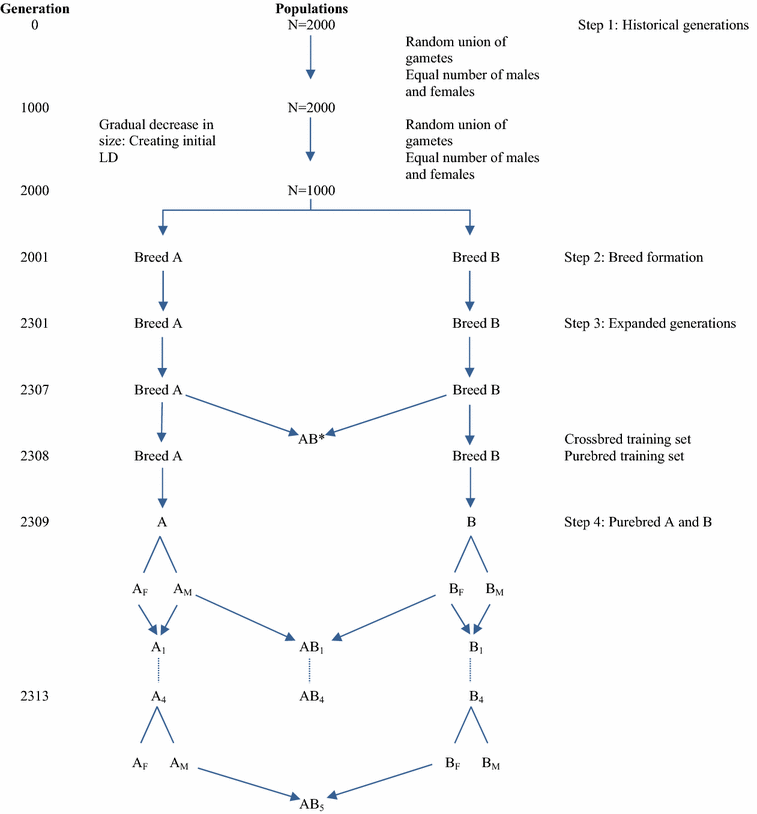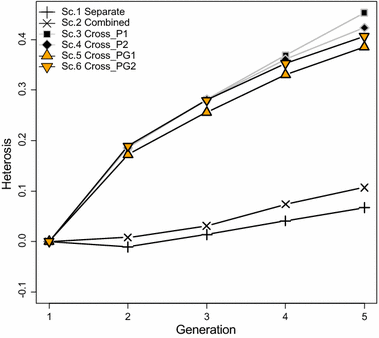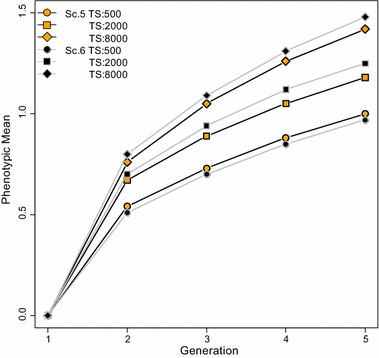A crossbred reference population can improve the response to genomic selection for crossbred performance
- PMID: 26419430
- PMCID: PMC4587753
- DOI: 10.1186/s12711-015-0155-z
A crossbred reference population can improve the response to genomic selection for crossbred performance
Abstract
Background: Breeding goals in a crossbreeding system should be defined at the commercial crossbred level. However, selection is often performed to improve purebred performance. A genomic selection (GS) model that includes dominance effects can be used to select purebreds for crossbred performance. Optimization of the GS model raises the question of whether marker effects should be estimated from data on the pure lines or crossbreds. Therefore, the first objective of this study was to compare response to selection of crossbreds by simulating a two-way crossbreeding program with either a purebred or a crossbred training population. We assumed a trait of interest that was controlled by loci with additive and dominance effects. Animals were selected on estimated breeding values for crossbred performance. There was no genotype by environment interaction. Linkage phase and strength of linkage disequilibrium between quantitative trait loci (QTL) and single nucleotide polymorphisms (SNPs) can differ between breeds, which causes apparent effects of SNPs to be line-dependent. Thus, our second objective was to compare response to GS based on crossbred phenotypes when the line origin of alleles was taken into account or not in the estimation of breeding values.
Results: Training on crossbred animals yielded a larger response to selection in crossbred offspring compared to training on both pure lines separately or on both pure lines combined into a single reference population. Response to selection in crossbreds was larger if both phenotypes and genotypes were collected on crossbreds than if phenotypes were only recorded on crossbreds and genotypes on their parents. If both parental lines were distantly related, tracing the line origin of alleles improved genomic prediction, whereas if both parental lines were closely related and the reference population was small, it was better to ignore the line origin of alleles.
Conclusions: Response to selection in crossbreeding programs can be increased by training on crossbred genotypes and phenotypes. Moreover, if the reference population is sufficiently large and both pure lines are not very closely related, tracing the line origin of alleles in crossbreds improves genomic prediction.
Figures




References
-
- Hartmann W. Evaluation of the potentials of new scientific developments for commercial poultry breeding. World Poultry Sci J. 1992;48:17–27. doi: 10.1079/WPS19920003. - DOI
-
- Comstock RE, Robinson HF, Harvey PH. A breeding procedure designed to make maximum use of both general and specific combining ability. Agron J. 1949;41:360–367. doi: 10.2134/agronj1949.00021962004100080006x. - DOI
-
- Bijma P, van Arendonk JAM. Maximizing genetic gain for the sire line of a crossbreeding scheme utilizing both purebred and crossbred information. Anim Sci. 1998;66:529–542. doi: 10.1017/S135772980000970X. - DOI
-
- Wei M, van der Steen H. Comparison of reciprocal recurrent selection with pure-line selection systems in animal breeding (a review) Anim Breed Abstr. 1991;59:281–298.
MeSH terms
LinkOut - more resources
Full Text Sources
Other Literature Sources

